Fede Alvarez’s Alien: Romulus is a fine franchise reboot
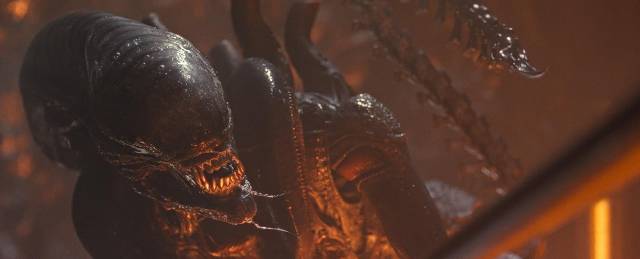
Perhaps the biggest surprise so far this year, and one of my most satisfying recent theatrical experiences, is Fede Alvarez’s Alien: Romulus (2024).
My only previous experience with Alvarez was Don’t Breathe (2016), a small, efficient thriller with a nasty twist at the end. But he’d previously made his feature debut with Evil Dead (2013) – an act of hubris which I had avoided; it always puzzles me when someone tries to remake something which is so indelibly identified with its original creators (in this case, director Sam Raimi and star Bruce Campbell). He went on to co-write and produce Don’t Breathe 2 (2021), a particularly nasty sequel, and yet another reboot of Texas Chainsaw Massacre (2022). So to be honest I didn’t have high expectations for an attempt to revive the Alien franchise – launched forty-five years ago with Ridley Scott’s groundbreaking original and wrapped up a quarter-century ago with Jean-Pierre Jeunet’s Alien: Resurrection (1997), which in retrospect seems more like Joss Whedon’s tryout for Firefly (2002). Scott’s own attempt at a reboot – or “reimagining” – with Prometheus (2012) was a tedious, pretentious mess which lost the tightly-focused concept in a morass of pseudo-philosophical noodling, while Covenant (2017) was a superfluous imitation of the earlier movies.
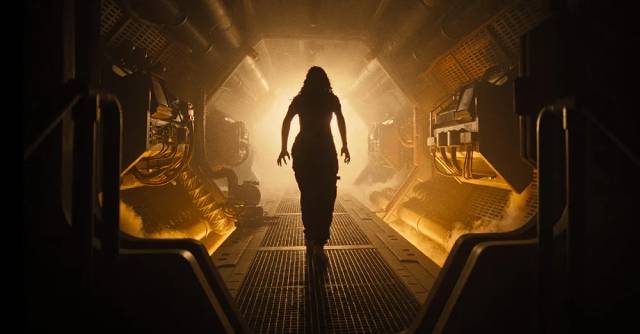
The idea of back-tracking and returning to basics seemed promising, but Alvarez’s limited filmography didn’t offer a great deal of hope. But the results far exceed those low expectations. The script, co-written by Alvarez and his usual partner Rodo Sayagues, shows a deep familiarity with the four original films and what made them work – in fact, for those who look, Romulus is loaded with knowing references, most of which are seamlessly integrated into the new narrative (the one jarring note comes near the end when the synthetic Andy says “get away from her, bitch” before dispatching a xenomorph – the direct quote from Aliens [1986] not only calls attention to itself, it’s inappropriate because this particular xenomorph isn’t a queen, just a basic ungendered soldier). But rather than a mere rehash of familiar elements, Romulus does some effective world-building of its own.
In a brief prologue, a salvage vessel finds the scattered remains of the Nostromo, blown to pieces at the end of Alien, and captures what we know is the possibly dead xenomorph. Then we find ourselves on a nightmarish mining colony which exists in perpetual night, the workers essentially enslaved by the Weyland-Yutani Corporation. If that opening sequence in space is fairly generic, the mining planet has a density and attention to detail which is reminiscent of Blade Runner’s Los Angeles – a nice nod to executive producer Ridley Scott’s better days. We meet Rain (Cailee Spaeny) and her “brother” Andy (David Jonsson), a synthetic salvaged by Rain’s father and programmed to look after her, though he has the personality of a young child (given to telling endless bad dad jokes). Rain heads for the company office hoping to arrange passage to a better planet since her term is up, only to be told by the clerk that her contract has been revised; not only has it been extended for six more years, she’ll be reassigned to work down in the mine, which is a certain death sentence.
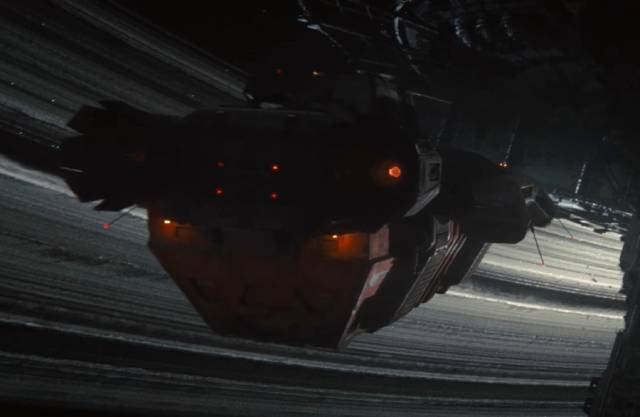
Very quickly, Alvarez establishes just how vile the company is and how callous it is about the lives of its “employees” – this is a grimmer depiction of the working lives we saw in the original film, as well as an echo of the penal colony in David Fincher’s Alien 3 (1992). This future isn’t all about shiny high adventure, but rather about brutal exploitation and the struggle to survive. This is a place where desperate people might take dangerous chances in the hope of finding something a little better.
Which is where Rain’s friends come in. Tyler (Archie Renaux), Kay (Isabela Merced), Bjorn (Spike Fearn) and Navarro (Aileen Wu) have access to a small ship and have discovered that there’s a decommissioned company vessel in an unstable orbit above them, a vessel which should include cryochambers which, if they can salvage them, will enable the group to make the nine-year trip to a better planet. It’s a risky plan and there’s a time limit since the derelict’s orbit is decaying and it will soon crash into the rocky bands of cosmic debris which encircle the planet like Saturn’s rings. The group bring Rain into the plan because they need Andy; as a WY synthetic, he’ll be able to gain them access to the derelict – but she’s initially reluctant because Bjorn is extremely hostile and abusive towards Andy. It turns out he hates all synthetics because one was responsible for his mother’s death.
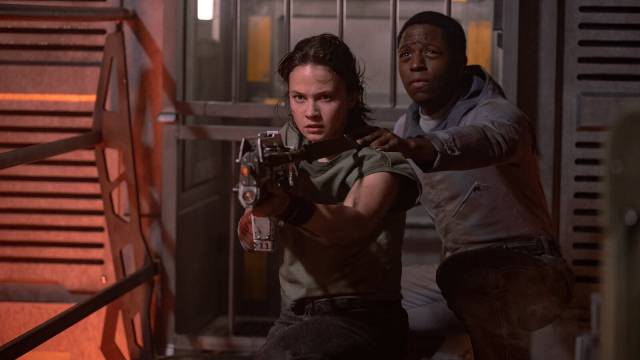
With differences in check, they take off and break free of the perpetual cloud cover, seeing the sun for the first time and discovering that the derelict is not in fact a ship, but rather a space station. When they board, they discover extensive damage and dead bodies. Given what the audience already knows, we recognize this as a research facility like the station in Resurrection and we have a pretty good idea what was being studied. From here, the movie is a synthesis of the original four films. We get thawed out face-huggers, chest-bursters metamorphosing into full-grown xenomorphs, acid eating through decks, and panicked characters trying to get the hell off the station as it drifts closer to the planet’s rings. (If I wanted to pick nits, I’d say that the evolution from chest-burster to full adult occurs too quickly and there are too many adults given the limited number of human hosts on the station.)
While the characters are perhaps not as well-developed as the crew of the Nostromo or the marines in Aliens, Alvarez gives them enough personality to engage the audience as he puts them through the gruelling paces of claustrophobic action in dark, tight spaces which increasingly swarm with aliens as Rain evolves into a worthy successor to Ripley – a connection hard to miss as Alvarez increasingly shoots her in positions and from angles which reference the earlier movies.
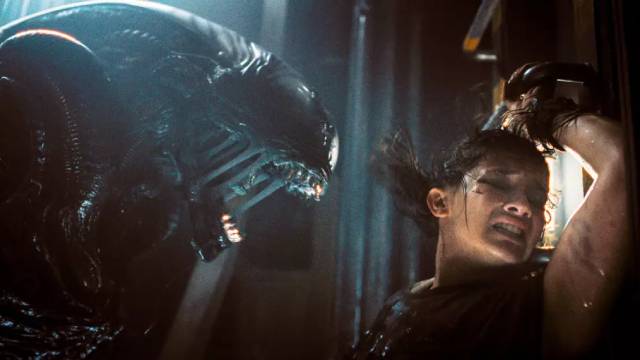
But the most character development actually goes to Andy, whose essential innocence is transformed when Rain removes a chip from a damaged synthetic and installs it in his operating system in order to give him access to restricted areas. (This involves a CG simulacrum of Ian Holm’s Ash in Alien, renamed Rook here, body torn in half and leaking white fluid; this kind of expropriation of a dead actor is a matter for more discussion than I have room for here.) Unfortunately, this replaces Andy’s protective concern for Rain with loyalty to company interests, which makes him dangerous to the group as he weighs odds and makes decisions to sacrifice them for the sake of his mission – that mission, of course, being to get the aliens back for further study by the weapons development department.
On top of all this, Kay is pregnant and, having been seriously injured, takes Andy/Rook’s word that a serum developed on the station will “repair” her – though it actually mutates her foetus and she gives birth to a new type of monster which is something like a cross between the hybrid from Resurrection and the Engineers from Prometheus. The latter is problematic because Scott’s reboot doesn’t really fit with the world of the original four movies, trying to shoehorn them into some supposedly larger, grander scheme. Dragging this echo into Romulus seems like an awkward attempt to tie two disparate conceptions together, though admittedly as a visual element the hybrid here does make for a creepy climax.
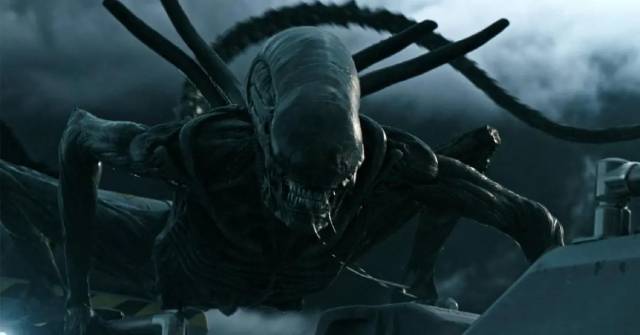 The strengths of Alien: Romulus are its dense, detailed depiction of a very bleak world and Alvarez’s ability to maintain a relentless momentum and an unrelieved sense of claustrophobic danger which nonetheless leaves room for character moments which make the action matter. It’s a worthy successor to the original four movies and a refreshing antidote to the tedium of Prometheus and Covenant.
The strengths of Alien: Romulus are its dense, detailed depiction of a very bleak world and Alvarez’s ability to maintain a relentless momentum and an unrelieved sense of claustrophobic danger which nonetheless leaves room for character moments which make the action matter. It’s a worthy successor to the original four movies and a refreshing antidote to the tedium of Prometheus and Covenant.
Comments